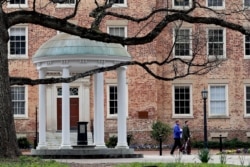Student Union
COVID-19 Infections Rising Among Young People on US University Campuses
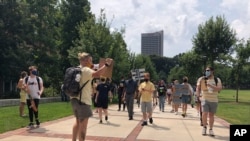
Reports of COVID-19 cases are growing on university campuses as schools reopen for the fall semester.
The University of North Carolina at Chapel Hill quickly reversed its in-person classes as 135 positive COVID-19 cases, 130 students and five employees emerged after the first week of classes from Aug. 10 to Aug. 16.
“We have seen COVID-19 positive rate rise from 2.8% to 13.6% at Campus Health,” stated a letter posted on Monday to the university’s website.
Almost 1,000 (954) students have been tested, 177 are in isolation and 349 are in quarantine, both on and off campus, according to the letter. The university will shift all undergraduate in-person instruction to remote learning, effective Wednesday, Aug. 19.
Oklahoma State University announced Aug. 15 there were 23 positive COVID cases in an off-campus sorority house. The entire house is in isolation or quarantine and will be prohibited from leaving the facility.
The University of Wyoming also reported Monday 38 active cases among students and staff.
Two involve students living in the university’s residence halls, and the other 36 cases involve students and employees living off campus. Both groups are in isolation.
Boston University’s ‘COVID-19 Testing Data Dashboard’ showed eight positive tests cumulative from July 27.
The University of Notre Dame in Indiana also saw a spike in COVID-19 cases, reporting 59 confirmed positive cases out of 654 total tests since Aug. 3.
Notre Dame officials stated in a letter, “the vast majority of the positive cases appearing in the university’s dashboard this week can be traced to a SINGLE off-campus gathering.”
“The students involved were forthcoming in sharing information with contact tracers. They shared who they interacted with, when and for how long. They also indicated individuals at the gathering were both outside and inside, together for some time, not wearing masks, in a crowded space, and drinking,” it continued.
A New York Times survey of 270 higher education institutions uncovered 6,600 COVID-19 infections among students and staff, as well as 14 coronavirus-related deaths over the course of the pandemic.
In the list, the University of Texas at Austin recorded the most positive cases, with 449 from March 1 to July 28.
University of Central Florida came in second with 438 cases, and University of Georgia recorded 390.
Although many colleges and universities offer comprehensive reopening plans with mask-wearing and social distancing guidelines, research shows that even with such reinforcements the virus would still roam throughout campuses, causing complications.
Philip Gressman, a professor of mathematics at the University of Pennsylvania, and Jennifer Peck, an economics professor at Swarthmore College, created a simulation to “determine whether in-person instruction could safely continue during the pandemic and evaluate the necessity of various interventions.”
The simulation studied the spread of a highly transmissible virus, such as COVID-19, at reasonably large research university and monitored the efficacy of interventions, such as contact tracing, mask-wearing, online instruction, etc.
It consisted of 20,000 students and 2,500 instructors who interacted daily for 100 days.
The results of Gressman and Peck’s model analyzed that a scenario with no interventions from the university would result in the number of people initially infected doubling every 2.185 days.
In other words, more than 2,000 people would be infected within 30 days of the first infection, and about 20,126 people, or 89.4% of the total campus population, would end up infected.
The model also studied the outcome of standard intervention, which would be a combination of quarantine and contact tracing, universal mask-wearing, daily randomized testing of 3% of the university community, and transitioning all classes with 30 or more students to online-only interaction.
Full standard intervention measures in universities “avoid the epidemic tipping point altogether” and keeps cumulative infections below 66 (out of 22,500) in more than 95% of simulations, according to the study.
Gressman and Peck wrote that allowing large in-person courses would increase infections from 43 to 538, and online classes with more than 30 students was the most effective at keeping infection rates low.
Requiring masks was moderately effective: not requiring masks would increase median infections to 131, they wrote. Random testing and contact tracing had the lowest impact, with removing either measures increasing infections to 50 and 47, respectively.
Researchers Kim Weeden and Benjamin Cornwell from Cornell University in New York analyzed how students are interconnected on a college campus and the implications of resuming in-person instruction during the coronavirus pandemic.
Weeden and Cornwell’s study stated that students are “highly interconnected” through their courses and that the nature of enrollment networks makes student populations susceptible to high rates of transmissions.
See all News Updates of the Day
Harvard students end protest as school agrees to discuss Gaza conflict

Protesters against the war between Israel and Hamas were voluntarily taking down their tents in Harvard Yard on Tuesday after university officials agreed to discuss their questions about the endowment, bringing a peaceful end to the kinds of demonstrations that were broken up by police on other campuses.
The student protest group Harvard Out of Occupied Palestine said in a statement that the encampment "outlasted its utility with respect to our demands." Meanwhile, Harvard University interim President Alan Garber agreed to pursue a meeting between protesters and university officials regarding the students' questions.
Students at many college campuses this spring set up similar encampments, calling for their schools to cut ties with Israel and businesses that support it.
The Israel-Hamas war began when Hamas and other militants stormed into southern Israel on October 7, killing some 1,200 people and taking 250 hostages. Palestinian militants still hold about 100 captives, and Israel's military has killed more than 35,000 people in Gaza, according to Gaza's Health Ministry, which doesn't distinguish between civilians and combatants.
Harvard said its president and the dean of the Faculty of Arts and Sciences, Hopi Hoekstra, will meet with the protesters to discuss the conflict in the Middle East.
The protesters said they worked out an agreement to meet with university officials, including the Harvard Management Company, which oversees the world's largest academic endowment, valued at about $50 billion.
The protesters' statement said the students will set an agenda that includes discussions on disclosure, divestment, reinvestment and the creation of a Center for Palestine Studies. The students also said that Harvard has offered to retract suspensions of more than 20 students and student workers and back down on disciplinary measures faced by 60 more.
"Since its establishment three weeks ago, the encampment has both broadened and deepened Palestine solidarity organizing on campus," a spokesperson for the protesters said. "It has moved the needle on disclosure and divestment at Harvard."
Chinese students report interrogations, deportations at US airports
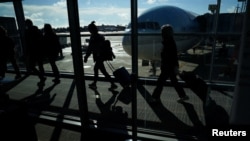
Academics from China are reporting increased scrutiny at U.S. airports, with valid visa holders being interrogated and turned away by Customs and Border Protection Agents.
Phones and laptops have been searched, and researchers have undergone extensive questioning about their work. One graduate student at Yale, who was midway through her PhD, was turned back at Dulles airport and banned from entering the U.S. for five years, according to The Guardian.
- By Phil Mercer
Australia plans limits on international students
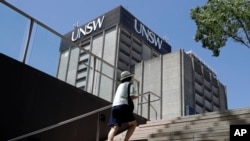
Australia says it will impose limits on the number of international students coming into the country to ease stress on housing and to reduce immigration.
The government in Canberra has said that international education programs, under which foreign students come to study in Australia, were fertile ground for immigration and visa fraud.
In 2023, official figures show that 787,000 international students studied in Australia, exceeding levels seen before the COVID-19 pandemic.
The Canberra government plans to cap the number of overseas students to ease stress on rental accommodation and to curb levels of immigration.
Senior government ministers have said caps for education would be part of a broader plan to manage migration, increase the availability of housing and to address skills shortages in the economy.
However, the university sector has insisted the proposals would damage Australia's global reputation as a welcoming, safe and world-class destination for students from other countries.
Education has been one of Australia’s most lucrative exports, but the left-leaning government in Canberra has said the international education sector, which includes many smaller private English language colleges, vocational and training institutions as well as larger universities, has been used as a way for unskilled migrants to stay in Australia.
Michael Wesley, the deputy vice chancellor at the University of Melbourne, told the Australian Broadcasting Corp. Tuesday that he hopes the government will target unscrupulous education providers.
“We welcome the crackdown on non-genuine education providers, which provide a backdoor into permanent residency for people who are not genuine students," Wesley said. "We are confident that all of our international students are genuine students and, so, we would hope that the impact of these visa caps will be at the non-genuine end of the education sector.”
Rental accommodation in many of Australia’s larger cities is often expensive and in short supply.
Analysts have said that surging prices are the result of years of underinvestment in affordable housing.
Education institutions would be required to build accommodations for their students if they wanted to exceed limits of the caps. Specific quotas for international students have not yet been made public.
The government in Canberra said it will change Australia’s Education Services for Overseas Students Act to give the education minister the authority to set limits on student enrolments for each education establishment, including specific courses or locations.
The majority of overseas students in Australia come from five countries: China, India, Nepal, the Philippines and Vietnam, according to government data. They contribute billions of dollars to the Australian economy.
Canada limits international student visas
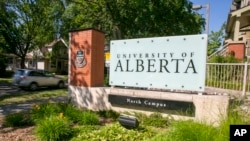
Saying the country has seen a massive spike in temporary immigrants – such as foreign workers – Canadian Prime Minister Justin Trudeau announced caps on international student visas.
Canada hosted more than 1 million international students in 2023, according to the Washington Post. That’s the same number as the United States, a country eight times its size. (April 2023)
Protests dwindle to tiny numbers, subtle defiant acts at US college graduations
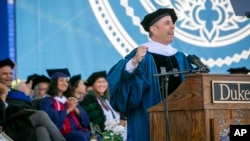
A tiny contingent of Duke University graduates opposed pro-Israel comedian Jerry Seinfeld speaking at their commencement in North Carolina Sunday, with about 30 of the 7,000 students leaving their seats and chanting "free Palestine" amid a mix of boos and cheers.
Some waved the red, green, black and white Palestinian flag. Seinfeld, whose decade-long namesake show became one of the most popular in U.S. television history and who continues to draw legions of fans to his Netflix specials and TV appearances such as "Comedians in Cars Getting Coffee," was there to receive an honorary doctorate from the university.
"After spending four years at what is considered one of the finest institutions of higher education in the world, they apparently feel that perhaps some light entertainment will get you all to the final realization, 'You know, I think I've really had enough of this place,'" Seinfeld said.
The stand-up turned actor and recent star, director and co-writer of the movie "Unfrosted," has publicly supported Israel since it invaded Gaza to dismantle Hamas after the organization attacked the country and killed some 1,200 people in southern Israel on Oct. 7. The ensuing war has killed nearly 35,000 people in Gaza, mostly women and children, according to Gaza's Health Ministry, which doesn't distinguish between civilians and combatants.
Students at campuses across the U.S. responded this spring by setting up encampments and calling for their schools to cut ties with Israel and businesses that support it. Students and others on campuses whom law enforcement authorities have identified as outside agitators have taken part in the protests from Columbia University in New York City to UCLA.
At the University of California, Berkeley, on Saturday, a small group of pro-Palestinian demonstrators waved flags and chanted during commencement and were escorted to the back of the stadium, according to the San Francisco Chronicle. There were no major counterprotests, but some attendees voiced frustration.
"I feel like they're ruining it for those of us who paid for tickets and came to show our pride for our graduates," said Annie Ramos, whose daughter is a student. "There's a time and a place, and this is not it."
The small student protest Sunday at Duke's graduation in Durham, North Carolina, was emblematic of campus events across the U.S. Sunday after weeks of student protests roiled U.S. campuses in recent weeks and resulted in nearly 2,900 arrests at 57 colleges and universities.
This weekend's commencement events remained largely peaceful.
At Emerson College in Boston, some students took off their graduation robes and left them on stage. Others emblazoned "free Palestine" on their mortar boards. One woman, staring at a camera broadcasting a livestream to the public, unzipped her robe to show a kaffiyeh, the black and white checkered scarf commonly worn by Palestinians, and flashed a watermelon painted on her hand. Both are symbols of solidarity with those living in the occupied territories.
Others displayed messages for a camera situated on stage, but the livestream quickly shifted to a different view, preventing them from being seen for long. Chants during some of the speeches were difficult to decipher.
Protests at Columbia University, where student uprisings inspired others at campuses across the country, led the school to cancel its main graduation ceremony in favor of smaller gatherings.
The University of Southern California told its valedictorian, who publicly backed Palestinians, that she could not deliver her keynote speech at its graduation ceremony because of security concerns. It later canceled its main graduation ceremony.
At Depaul University in Chicago, graduation is more than a month away. But as the academic year closes, school leaders said they had reached an "impasse" with the school's pro-Palestinian protesters, leaving the future of their encampment on the Chicago campus unclear.
The student-led DePaul Divestment Coalition, which is calling on the university to divest from economic interests tied to Israel, set up the encampment nearly two weeks ago. The group alleged university officials walked away from talks and tried to force students into signing an agreement, according to a student statement late Saturday.




